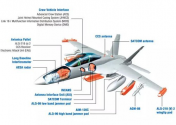Are you sure VHF radars are easier to jam? I heard this multiple times but I didn't found any evidence. Proportion wise VHF band is much wider than X-band after all. It is plausible that an antenna optimized for 8 GHz would work well enough at 12 GHz but an antenna optimized for 30 MHz would suck for 300 MHz. As for as I know, antenna selection is all about proportions. Also, most aircraft do not even carry any equipment that would generate or detect VHF waves effectively. As for as I know the F-35 has some little capability for detecting and jamming VHF radars with a set of large antennas at leading edges but beyond that VHF and HF are dealt with dedicated EW systems.Finally, the aggressor will always employ electronic attack aircraft together with stealth aircraft. Jamming VHF/UHF radars is typically easier than higher frequency radars. A VHF radar is limited to the range of 30 to 300 MHz (max. bandwidth: 0.27 GHz). That makes it a far easier task to jam than an X-band radar that operates within a 4GHz (8GHz-12GHz) frequency range. Finally, their poor angular resolution makes them susceptible to geometric spoofing techniques.
There's a good chance that a pack of F-35s following a Growler could kill a loner Nebo radar with their SDBs without ever being detected. But in a large defense network of multiple radars and AEW aircraft, a VHF radar is a welcome asset as it further complicates enemy attack plans.
The 40N6 missile is an active-radar homer. Intermediate range (200km and 250km) missiles are SARH and <120km range are ARH.
Also, thank you for the correction about 40N6. I probably thought of 200 and 250 km range missiles.

